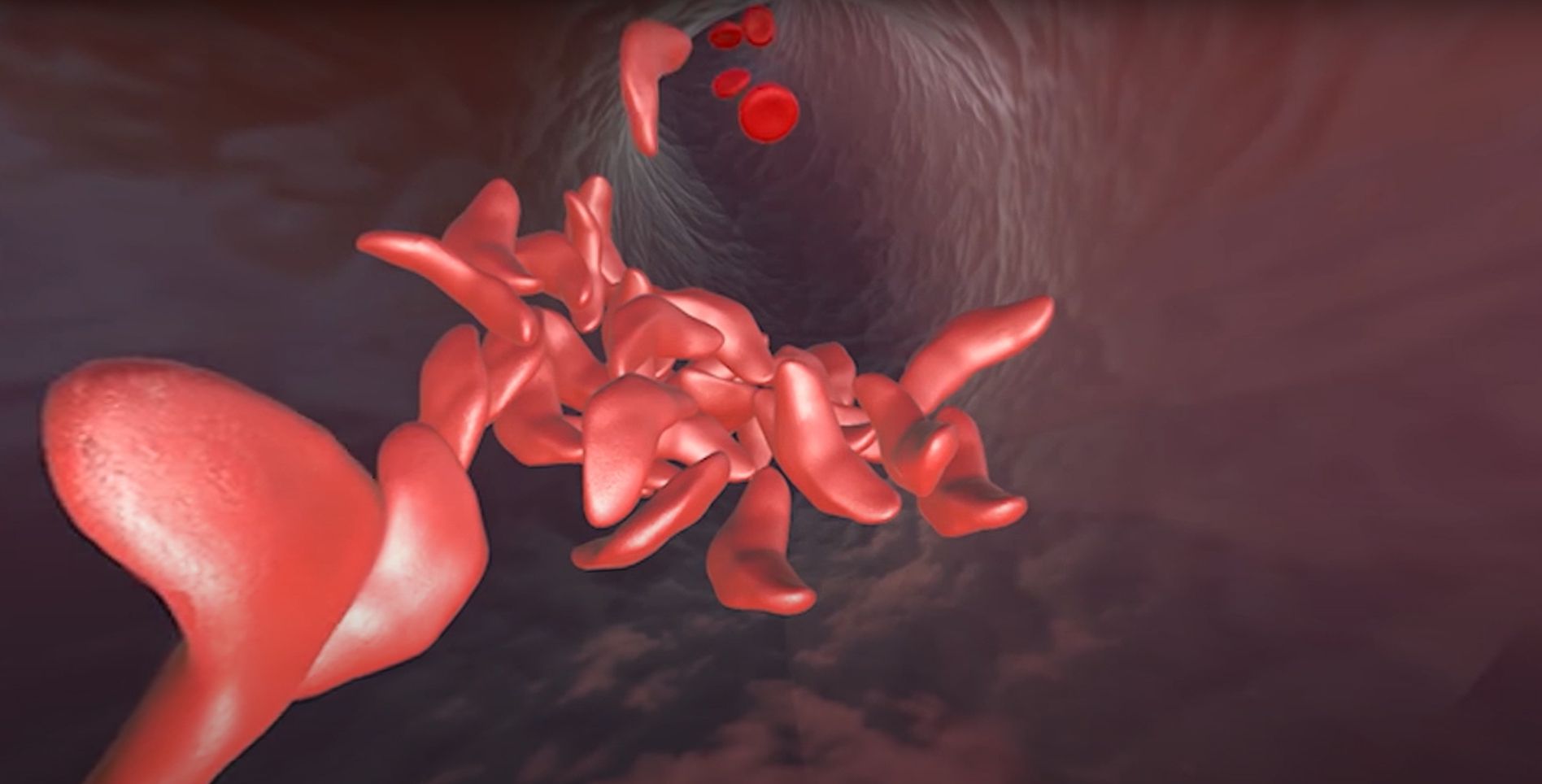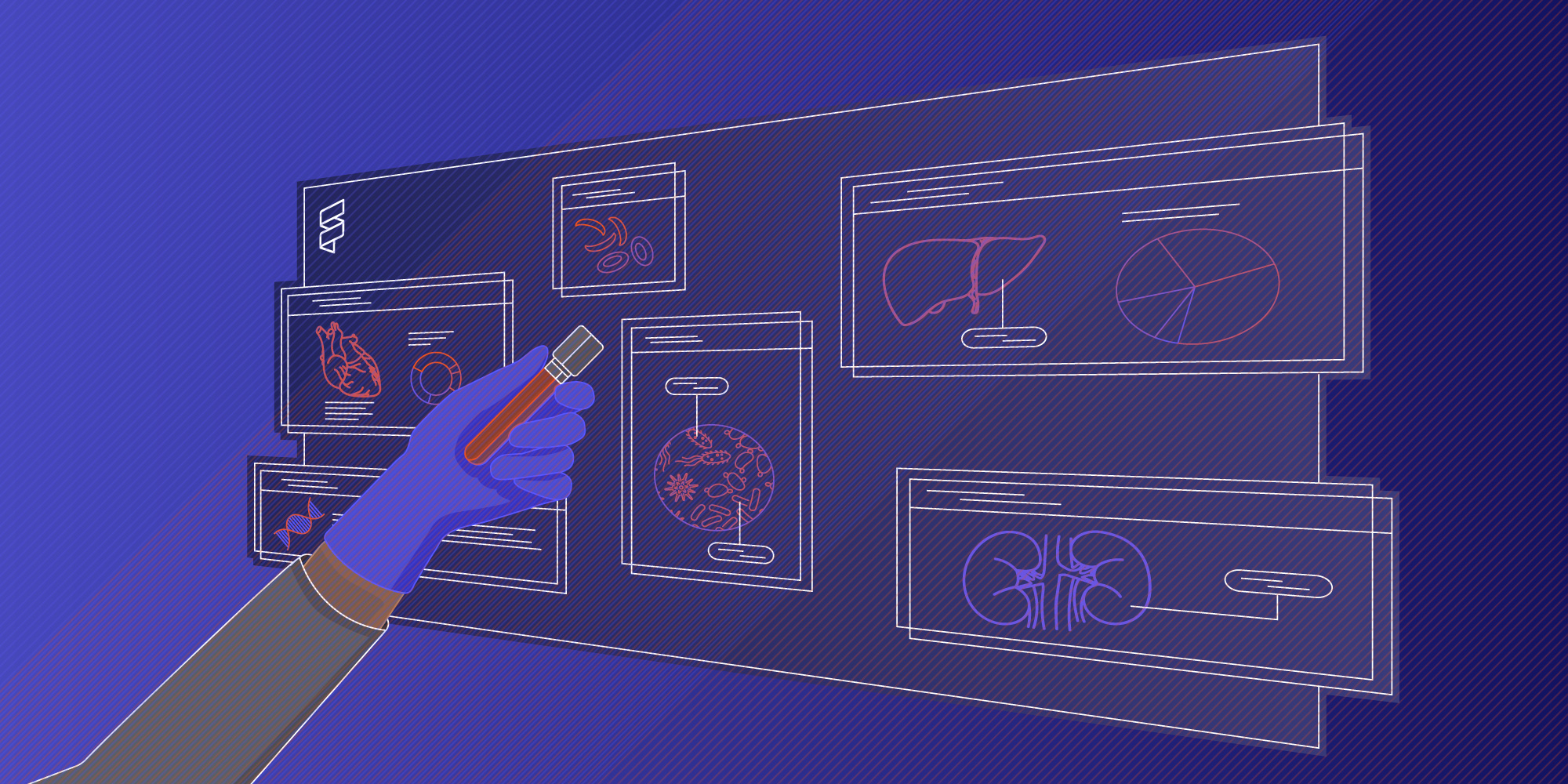
It is a remarkable time for the development of CRISPR-based therapies. In late 2023, we saw the first-ever approval of CRISPR-based medicine: Casgevy, a cure for sickle cell disease (SCD) and transfusion-dependent beta thalassemia (TDT). The IGI has tracked the progress of CRISPR clinical trials since they first began, and this milestone has been anticipated for some time, but its speed is still noteworthy.

“Going from the lab to an approved CRISPR therapy in just 11 years is a truly remarkable achievement,” says IGI Founder Jennifer Doudna. “I am especially pleased that the first CRISPR therapy helps patients with sickle cell disease, a disease that has long been neglected by the medical establishment. This is a win for medicine and for health equity.”
With one CRISPR-based therapy across the finish line, we’re entering a new phase in the clinical development of genome editing in medicine.

“At this point, all hypotheticals, the words ‘potentially’ and ‘could’ or ‘in principle’ are gone,” says Fyodor Urnov, IGI’s Director of Technology & Translation. “CRISPR is curative. Two diseases down, 5,000 to go.”
The enthusiasm in the field still has to face some significant real-world hurdles. Overall, the CRISPR medicine landscape has shifted significantly since our last update and Spring 2023. Market forces have reduced venture capital investment in biotechnology. Investors want to see returns, which means companies are hyper-focused on clinical trials and getting new products to market as quickly as possible to return on investment. Combined with the high price of clinical trials, financial pressure has led to layoffs in a number of CRISPR-focused companies and a narrowing of focus on their furthest developed products, rather than developing their pipeline of new treatments and expanding disease areas. This year, we see a trial in only one new disease area: autoimmunity.
Innovative approaches to regulating CRISPR therapies and supporting clinical trials, especially for rare diseases, could help expand the pipeline. We’ll touch on this more at the end of the piece. First, we’ll cover the current clinical trials.
BLOOD DISORDERS
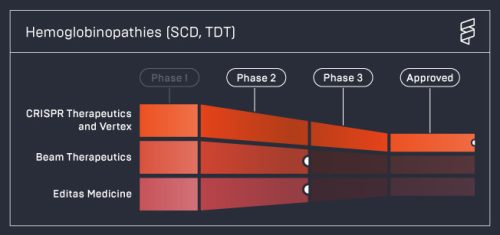
Sickle cell disease (SCD) and another genetic disorder affecting the hemoglobin in red blood cells, transfusion-dependent beta thalassemia (TDT), were among the first targets of CRISPR-based treatments. CRISPR Therapeutics and Vertex, the makers of Casgevy, as well as a number of other groups, take the approach of inducing expression of fetal hemoglobin (HbF), a kind of hemoglobin usually only found in fetuses and very young infants. If the gene for fetal hemoglobin is turned “on” in adults, it can do the job of the healthy adult hemoglobin that individuals with SCD and TDT are missing.
THE APPROVAL OF CASGEVY
On November 16, 2023, the UK’s Medicines and Healthcare Products Regulatory Agency approved Casgevy for the treatment of SCD and TDT in patients aged 12. The US Food and Drug Administration (FDA) followed with an approval for SCD on December 8, 2023. These were the first-ever approvals of a CRISPR-based therapy. Casgevy has since been approved in the US for the treatment of TDT, approved in the EU, and given conditional approval in Bahrain. A regulatory submission is in review with the Saudi FDA, with submission planned in Canada in 2024.
These approvals come following data from a phase 3 trial in both adults and children with severe SCD or TDT. CRISPR Therapeutics and Vertex have shared data from 17 patients with SCD and 27 patients with TDT: the results are dramatic and durable.
25 of 27 individuals with TDT were no longer transfusion dependent following the treatment, some for longer than three years. The other two patients had significant reductions in transfusion frequency (80%, 96%). 16 of 17 SCD patients are free of the vaso-occlusive crises that characterize the illness following treatment. The other patient has been free of hospitalizations related to vaso-occlusive crises.
In all the patients who received Casgevy, increases in fetal hemoglobin occurred within the first few months and were maintained over time. Even without directly repairing the mutations that cause SCD or TDT, this treatment seems to be a functional cure for SCD and TDT. Hear from Victoria Gray, a participant with SCD who has experienced a remarkable recovery since undergoing treatment.
Much remains to be seen about access to Casgevy. The first issue is technological access: the treatment is challenging to manufacture and to deliver. Few locations in the United States or abroad have the technical ability and expertise to deliver the treatment.
The second set of challenges is financial access. Casgevy is priced at around $2 million per patient. Because the lifetime cost of care for individuals with SCD or TDT is so high, covering the treatment may be a sound strategy, particularly in countries with single-payer healthcare systems. In the United States, the incentive structure may prove to be more challenging. We will be keeping a keen eye on how insurance and Medicaid coverage play out in real life.
In addition to access and pricing issues, there are risk considerations. The chemotherapy required before administering the CRISPR treatment is tough on patients and carries the risk of serious side effects. Improving safety and patient experience, as well as reducing costs, are driving continued research on next-generation therapies.

OTHER SCD AND TDT TRIALS
Editas Medicine is also conducting phase 1/2 trials for individuals with severe SCD and TDT, but using a CRISPR system with a Cas12a protein rather than the more famous Cas9 protein. Their approach, similar to Casgevy, is to create edits that turn on HbF. This is the first time Cas12 has been used in a clinical trial. So far, 17 participants have been treated. No serious adverse events have been reported, and the efficacy seems to be as strong as that of Casgevy: all of the SCD patients (11) show robust increases in fetal hemoglobin levels and have been free of vaso-occlusive events since they received the treatment (a minimum of five months). The 6 TDT patients have likewise had strong increases in hemoglobin that negate the need for transfusion. The treatment has been given orphan drug and RMAT designations by the FDA. Editas plans to treat more participants in the US and Canada, sharing more data in the summer of 2024.
In January 2024, Beam Therapeutics announced that they had dosed the first participant in their US-based phase 1/2 trial of a base editing therapy for severe SCD. Beam is using base editing to turn on HbF. Base editing is a version of CRISPR-Cas9 technology that changes single DNA letters, or nucleotides, without creating double-stranded breaks in DNA, reducing certain safety risks. Beam is planning to dose another two participants soon and expects to share data in the second half of 2024.
A UC Consortium phase 1 trial is currently the only non-profit trial in the space, and the only one that aims to directly repair the SCD mutation. It has been delayed due to manufacturing challenges, but plans to begin enrolling in early 2025.
Read more:
- FDA Approves First Gene Therapies to Treat Patients with Sickle Cell Disease
- FDA approves first gene-editing treatment for human illness
IMPROVING CRISPR TREATMENTS FOR SCD & TDT
CRISPR Therapeutics and Beam are both pursuing strategies for in vivo editing for SCD and TDT. Right now, all of the therapies are ex vivo: the cells are taken out of the body, edited and quality-controlled in a special lab, and then put back in the body after the patient undergoes intensive chemotherapy. In vivo therapy would mean delivering the genome-editing medicine directly into the patient’s body, where the cells will be edited.

Both companies are also investigating reducing the burden of chemotherapy conditioning by targeting the chemotherapy to specific cells with antibodies, ultimately allowing the use of lower doses. While CRISPR Therapeutics is farther along, all of this research is early-stage. But it’s something to keep an eye on — if successful, these developments would reduce the burden on patients and in vivo editing could make treatment much more widely accessible.
“There is no doubt in my mind that in a decade we will move editing outside of the realm of the bone marrow transplantation unit and into a setting where the patient gets an IV injection. The path lies through the formidable obstacle of the risks of having something untoward happen,” says Urnov. “When you edit cells outside of the body, you test for quality control. Any in vivo editing regime for sickle cell disease, by definition, cannot involve this quality control step.”
CHRONIC BACTERIAL INFECTION
Urinary tract infections (UTIs) are a common infection that disproportionately affects women and causes over 8 million visits to health care providers every year. While most UTIs are easily treated with a short course of antibiotics, sometimes antibiotics are ineffective or the infection keeps recurring, leading to chronic UTIs.
The treatment currently in clinical trials is a cocktail of three bacteriophages combined with CRISPR-Cas3, designed to attack the genome of the three strains of E. coli responsible for about 95% of UTIs. The destruction of the genome kills the bacteria.
Bacteriophages, or phages for short, are viruses that attack bacteria. In this treatment, in addition to the natural action of phages that kills bacteria, the bacteriophages are engineered to contain CRISPR-Cas3 in their genome. Lesser known than its famous cousin Cas9, Cas3 shreds DNA at the gene regions it is targeted to find. In this treatment, the CRISPR-Cas3 system is made to target the genomes of the targeted E. coli strains. Locus Biosciences delivered the treatment directly to the bladder by catheter.
Locus Biosciences completed their US-based Phase 1b trial in February 2021. Locus’s trial was the first trial using a CRISPR-based therapy to treat infection. It is also the first trial to use the Cas3 protein. In press releases, Locus reported that results of the trial supported the safety and tolerability of the new therapy, with no drug-related adverse effects. No data have been published yet, but Locus says the initial results show a decrease in the level of E. coli in the bladder of participants given the CRISPR-based treatment.
Locus began enrolling participants for a phase 2/3 trial in 2022, and announced dosing of the first participant in September 2022. They plan to enroll approximately 800 participants from the US and European Union. No clinical updates or interim data have been reported.
Read more:
PROTEIN-FOLDING DISEASE
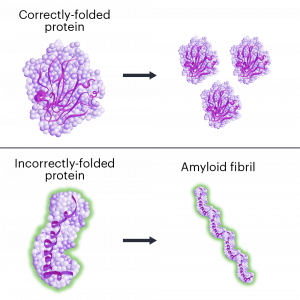
Hereditary transthyretin amyloidosis (hATTR) is a fatal disease caused by mutations in a single DNA letter in the gene TTR, leading to a faulty version of the TTR protein. ATTR has similarities to other neurological diseases involving protein misfolding and amyloidosis including Alzheimer’s and Parkinson’s diseases. The treatment being investigated uses CRISPR-Cas9 tools to reduce the amount of faulty TTR protein the body makes and is delivered in a single dose by IV.
This is the first clinical trial for a CRISPR-Cas9 therapy delivered in a lipid nanoparticle (LNP). LNPs have a tendency to accumulate in the liver. TTR is primarily made in the liver, so LNPs are a clever choice for getting the treatment to where it is needed. This is also the first trial to deliver genome-editing components systemically — that is, to the whole body rather than to one specific type of cell or tissue.
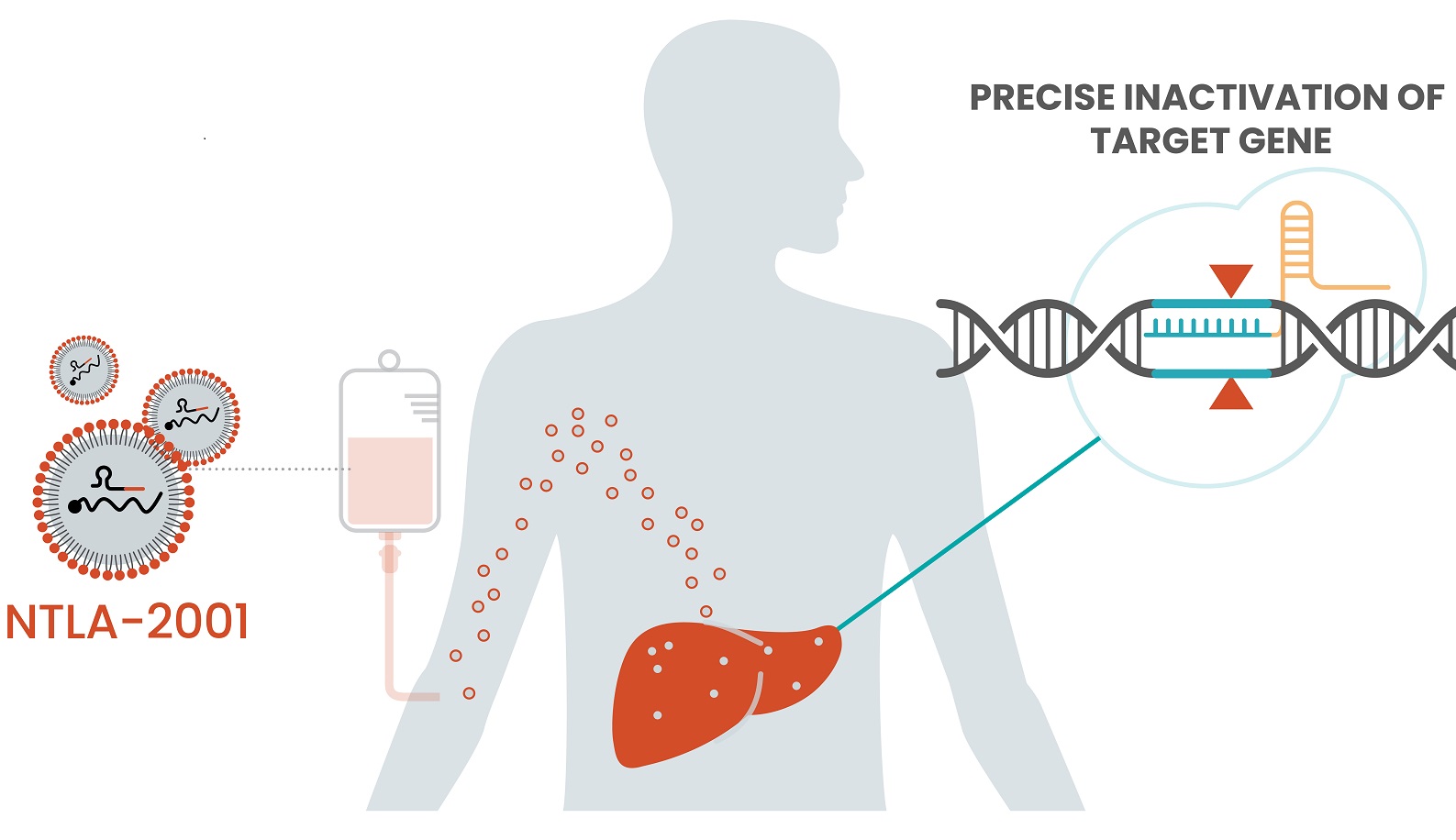
The trial, sponsored by Intellia Therapeutics with sites in the EU, UK, and New Zealand, has two arms and dosed the first participants in late 2020. One arm is studying patients with neuropathy symptoms and the other is studying patients with with cardiomyopathy symptoms. Between the two arms, efficacy data has been reported on 62 participants at a range of doses. Even at the lowest treatment dose, there is a deep (>85%) reduction in the amount of toxic protein in the participants’ blood streams, with greater than 90% reduction for participants receiving the highest dose. All patients are showing sustained reduction in the TTR protein over time, including the patients for whom two years of findings have been reported. As TTR protein levels correlate with disease severity, researchers are very optimistic about participant outcomes. Some side effects have been observed, with mild infusion-related events particularly common. 7 of 65 participants experienced serious adverse effects. All patients remain in the study and a dose in the middle of the testing range has been selected to move forward for further testing.
Intellia has gotten FDA approval to move forward with a phase 3 study of NTLA-2001. This study will be double-blind and placebo-controlled, enrolling participants in the US and around the globe. These trials will be aimed at collecting sufficient efficacy data for treatment approval by the FDA and other regulatory agencies.
Read more:
- CRISPR-Cas9 In Vivo Gene Editing for Transthyretin Amyloidosis — Gillmore et al., New England Journal of Medicine
- The latest data from Intellia
INFLAMMATORY DISEASE
In hereditary angioedema (HAE), an individual has severe attacks of inflammation, leading to swelling, often in the arms and legs, face, intestines, or airway. These attacks are painful and swelling of the airways can be life-threatening. Without treatment, attacks occur every 1–2 weeks, lasting 3–4 days each. HAE affects about 1 in every 100,000 people.
The treatment that is currently in clinical trials uses CRISPR-Cas9 tools to reduce the amount of an inflammatory protein the body makes. As in the hATTR treatment, the aim isn’t to fix a gene, but to break a gene to stop a disease process. As in hATTR, the liver is the main site of protein production, and Intellia Therapeutics again used lipid nanoparticles to deliver the therapy. This is an in vivo, systemic treatment, administered intravenously in a single dose.
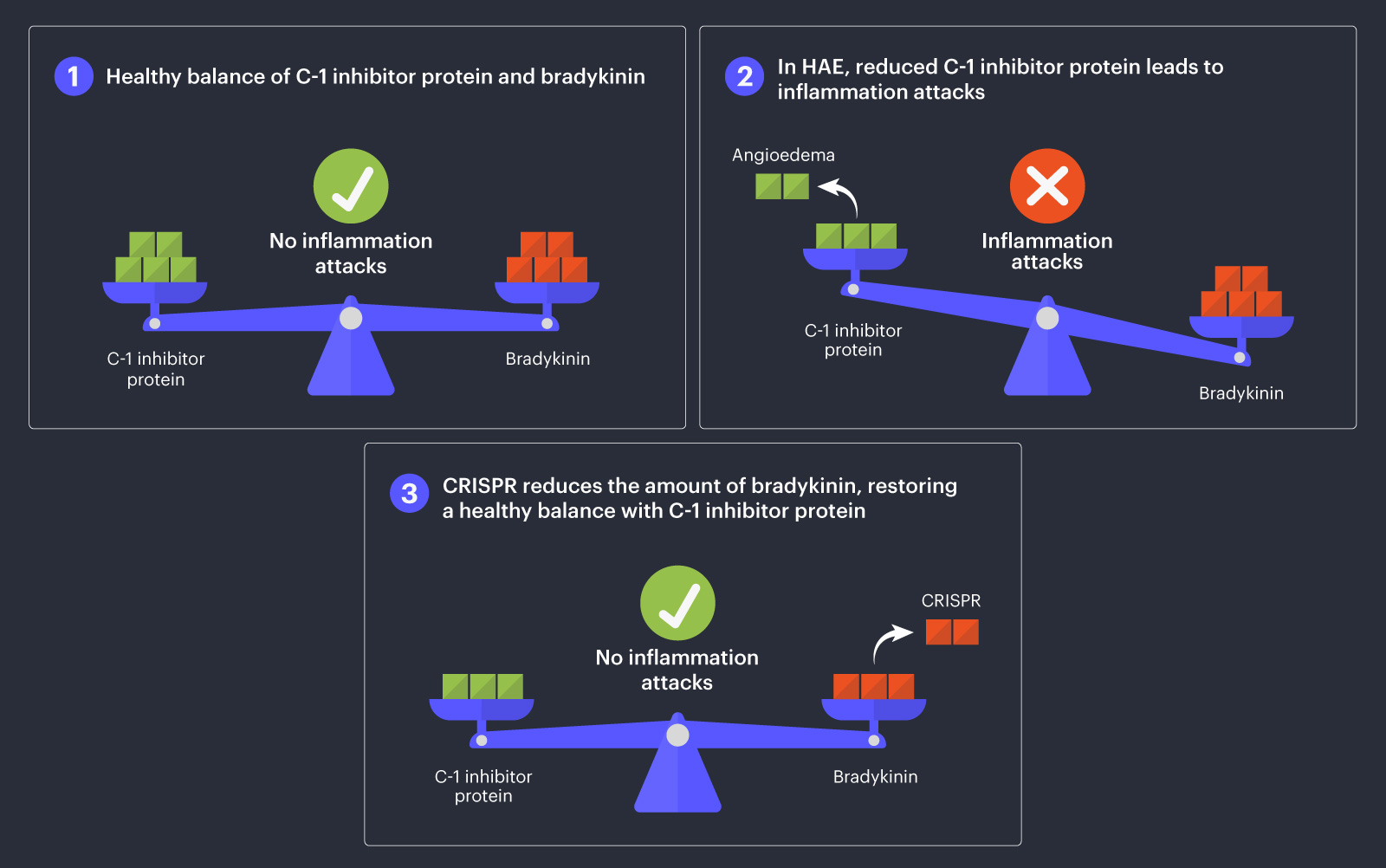
For HAE, researchers will use blood testing to see if the genome-editing components are successfully reducing the levels of proteins that cause inflammation as well as the number of inflammation attacks after treatment.
Early-stage trials are designed to test safety and find the appropriate dosage of the treatment. Intellia started dosing patients in New Zealand in 2020, testing a range of 3 doses on a total of 10 participants. Most participants have been free from attacks in the interval between treatment and their most recent follow-up — as long as 13 months. Four months after treatment, there was a reduction in the amount of inflammatory protein of an average of 64% in the lowest dose group and over 90% in the highest dose group. The treatment has been well tolerated at all dose levels, with no severe adverse events. Six participants discontinued use of their other HAE preventative treatments and remained free of attacks. These results are extremely encouraging, suggesting the one-time treatment may represent a functional cure for this type of HAE.
Participants from New Zealand, the US, and other locations have been dosed for the phase 2 portion of the trial, but no results have been released yet. Intellia plans to initiate a global phase 3 trial later this year.
The US FDA has given the treatment orphan drug and RMAT designations. In the EU, the treatment has been granted orphan drug and PRIME designations by the European Medical Agency. In the UK, the treatment has been granted an Innovation Passport, which is similar to the FDA’s Fast Track program.
Read more:
CANCERS
In CAR-T immunotherapy, researchers genetically engineer T cells to have a receptor that recognizes a patient’s cancer cells, telling the T cells to attack. The FDA approved CAR-T made with traditional gene therapy in 2017 and it’s proven to be an effective approach. With CRISPR, researchers are hoping to make it even more powerful.
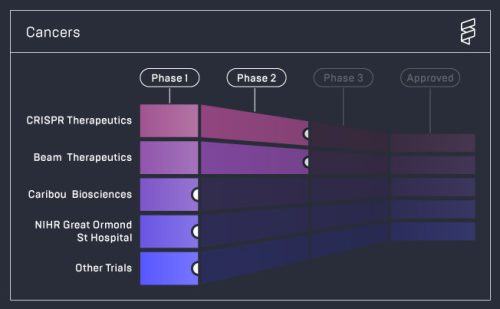
Most CAR-T therapies are autologous: cells are taken from an individual patient, edited, multiplied, and then put back into the same patient. Autologous CAR-T and have long-lasting benefits for individuals with cancer. The treatment is completed with a single dose, but the process is expensive, time-consuming, and few facilities can do it. And sometimes the manufacturing process just doesn’t work, produces low potency cells, or individuals die of their disease while waiting for the manufacturing to be completed.
A central focus for CRISPR researchers over the past several years has been making allogeneic CAR-T cells: cells from a healthy donor. These cells are edited to attack cancer cells and avoid being targeted by a recipient’s immune system, and then multiplied into huge batches which can be given to large numbers of recipients on demand. It has been hoped that allogeneic products would reduce cost, time until treatment, and provide consistently high-quality cells.
“Allogeneic CAR-T cells are incredibly challenging because you need to fight against cancer, but you also need to fight against the host immune system that can reject the CAR-T cells,” says Justin Eyquem, a cancer researcher based at UC San Francisco. “What we’ve been seeing over the past several years is that initially there is a high response rate to the allogeneic CAR-T therapy, but then the CAR-T cells are rejected and so we get frequent relapses. Using similar autologous cells, we have seen more prolonged anti-tumor responses.”
At this point, allogeneic CAR-T cells are largely being used as a bridge to stem cell transplant for leukemias and lymphomas, whereas autologous cells are a complete therapy on their own. So far, allogeneic CAR-T cells have so far not met the high hopes for them and investor excitement seems to have cooled, but researchers are continuing to seek new ways to make them more effective because they would offer significant advantages in cost and scalability. Still, companies are continuing to make improvements to their autologous CAR-T cells, including introducing additional edits to help them evade rejection by the patient’s immune system.
LEUKEMIAS & LYMPHOMAS
We previously reported that CRISPR Therapeutics was testing two kinds of allogeneic CRISPR-modified CAR-T cells in phase 1 clinical trials. One targeted CD70, a protein often present on the surface of cancerous cells in lymphomas and some solid tumors. The other treatment from CRISPR Therapeutics targets CD19, a protein often present on the surface of cancerous cells in leukemia and lymphoma. Read more about these types of cancers in 2022’s clinical trials deep-dive.
After sharing positive data from these trials, CRISPR Therapeutics decided to close them, opening instead phase 1/2 trials with the same targets, but featuring their next-generation technology. These changes include edits to two more genes, Renase-1 and TGFBR-2, that act as brakes on T cell anti-cancer activity. CRISPR Therapeutics reports that the next-generation treatments have better manufacturing profiles, producing more CAR-T cells per batch. The treatment targeting CD70 is being tested in individuals with kidney carcinomas and other solid tumors. The treatment targeting CD19 is being used in individuals with certain kinds of lymphomas and leukemias.
Two other groups have had impressive results targeting CD19 for hard-to-treat, aggressive non-Hodgkin’s lymphomas. Caribou Biosciences is testing CAR-T cells that, in addition to targeting CD19, have a second genetic modification: knockout, i.e. genetic deactivation, of PD-1, a gene that cancer cells sometimes use to evade the immune system. The treatment was generally well-tolerated with an acceptable safety profile. In a US-based phase 1 trial of 16 participants, 15 responded to the treatment, with seven of 16 (44%) having a complete remission lasting six months or longer. 24 months is the longest complete remission maintained at the last reporting of data. The FDA has granted their product RMAT, Fast Track, and orphan drug designations. At this time, Caribou is enrolling an additional 30 participants from the US, Australia, and Israel to help determine what dose to use in a phase 3 trial. They intend to go directly from phase 1 to a pivotal phase 3 trial, initiating the phase 3 trial by the end of 2024.
In 2023, Caribou initiated two more phase 1 allogeneic CAR-T trials. Their anti-BMCA CAR-T cells target multiple myeloma and their anti-CLL-1 CAR-T cells target acute myeloid leukemia. Both trials are US-based. No results have been reported yet.
A team out of the UK’s NIHR Great Ormond Street Hospital Biomedical Research Centre shared results from a small phase 1 trial using CD19-targeting cells in children with B cell leukemias, which achieved its safety aims. All together, this paints a promising picture for advances in treating blood cancers.
Read more:
- More about CAR-T targeting CD19
- More about effects of targeting CD70 in cutaneous lymphomas & the RMAT designation for this indication
- Caribou’s release of phase 1 data
- Non-viral, specifically targeted CAR-T cells achieve high safety and efficacy in B-NHL — Nature paper with the Bioray study
- Phase 1 clinical trial of CRISPR-engineered CAR19 universal T cells for treatment of children with refractory B cell leukemia — Science Translational Medicine paper on the study from the UK group
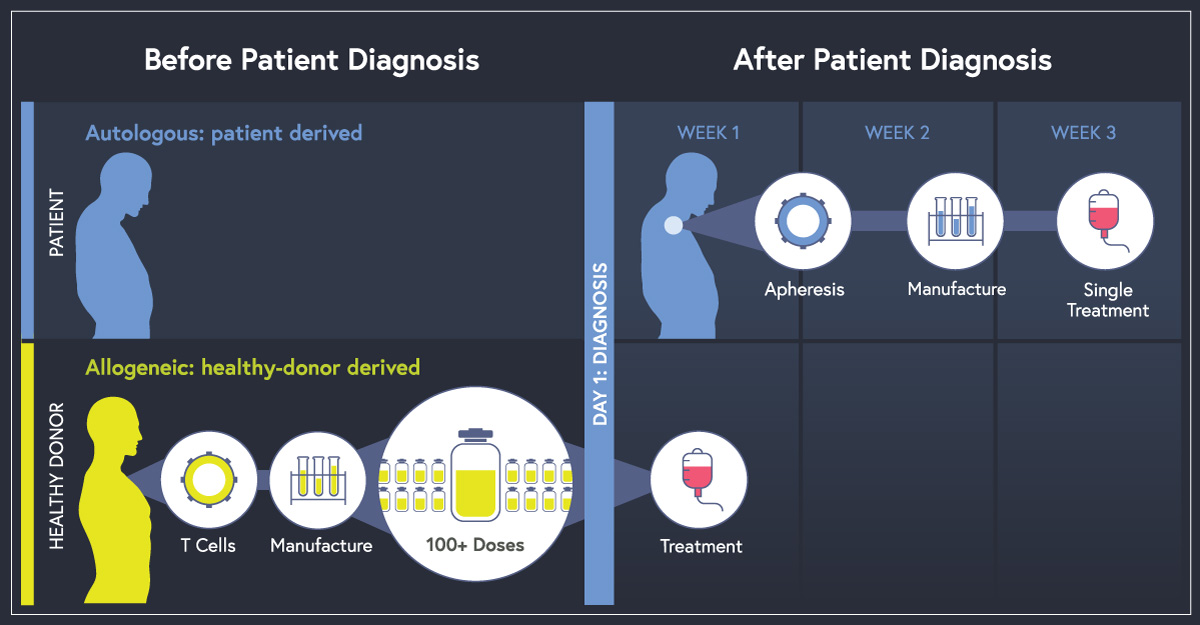
In 2022, the same Great Ormond Street group reported treating a teenager with CAR-T cells made with base editing, a kind of CRISPR-based editing that can make small changes to DNA without creating a double-stranded DNA break. This was the first use of base editing in a clinical trial. The teen, Alyssa, was treated with base-edited anti-CD7 CAR-T cells, made from allogeneic, or donor, cells. The treatment led to remission and serves as a bridge to a stem cell transplant, which can cure leukemia. In 2023, the group published a paper with results from two more teens with leukemia. One had successfully received the CAR-T treatment, gone into remission, and was awaiting transplant. The other responded to treatment but died from a fungal infection.
Side effects of the treatment included significant inflammatory response in the form of cytokine release syndrome and opportunistic infections from immune system depression. While these side effects are significant, they must be weighed against outcomes without the treatment. Each of these teens had previously been treated but had relapsed. At that point, the prognosis was very poor and the alternative was palliative care. The group intends to treat a total of 10 patients in this phase 1 study and we expect to see more results shared in future.
Beam Therapeutics, a biotech company that uses base editing, reported dosing the first patient in their phase 1/2 of an anti-CD7 CAR-T treatment for T cell leukemia and lymphoma. Their cells also have edits to eliminate expression of three additional genes. Enrollment is ongoing and they expect to report data in the second half of 2024.
Read more:
- Base-Edited CAR7 T Cells for Relapsed T-Cell Acute Lymphoblastic Leukemia
- Gene-editing ‘pencil’ saves two teenagers dying from cancer, putting their leukemia in remission
SOLID TUMOR CANCERS
We previously reported encouraging data from CRISPR Therapeutics’s trial using their allogeneic CD70-targeting CAR-T cells in individuals with solid tumors of the kidney. CRISPR Therapeutics has discontinued investigating this treatment, instead focusing on a next-generation version of the therapy with edits to additional genomic targets. We expect initial results from this trial to be reported later this year.
There are at least three other other phase 1 trials ongoing for solid cancers, including gastrointestinal, and epithelial-cell-derived cancers like breast and pancreatic cancers, but no results from these have been released yet.
Read more:
- CRISPR Therapeutics releases data on renal carcinoma treatment
- PACT Pharma Reports Data From First Clinical Study Using CRISPR to Substitute a Gene in Patients’ Immune Cells to Treat Cancer
- Non-viral precision T cell receptor replacement for personalized cell therapy — Nature paper with data from the PACT trial
CARDIOVASCULAR DISEASE
High levels of LDL cholesterol — so-called “bad cholesterol” — are a major risk factor for cardiovascular disease and premature death. Genetics play a role in cholesterol levels. Some individuals have mutations in the gene PCSK9 that leads to familial hypercholesterolemia: a heritable condition that causes dangerously high levels of cholesterol regardless of diet and exercise.
In 2022, Verve Therapeutics began their trial for a subtype of familial hypercholesterolemia using a base editor delivered by lipid nanoparticle (LNP). Base editing is a form of CRISPR-based editing that can make small changes to DNA sequences without making a double-stranded break in the DNA. Double-stranded breaks create unique risks to cells, and base editing, when applicable, may be a safer alternative to conventional CRISPR-based editing. In this case, the editor is designed to make a single letter change in the PCSK9 gene. As in the case of hATTR and HAE, the liver is the major site of production of the protein in question. Lipid nanoparticles have a natural affinity for the liver, so LNP infusion is an obvious choice for delivery. Because the delivery is non-viral, the CRISPR components should only be present transiently, minimizing the risk of unwanted edits.
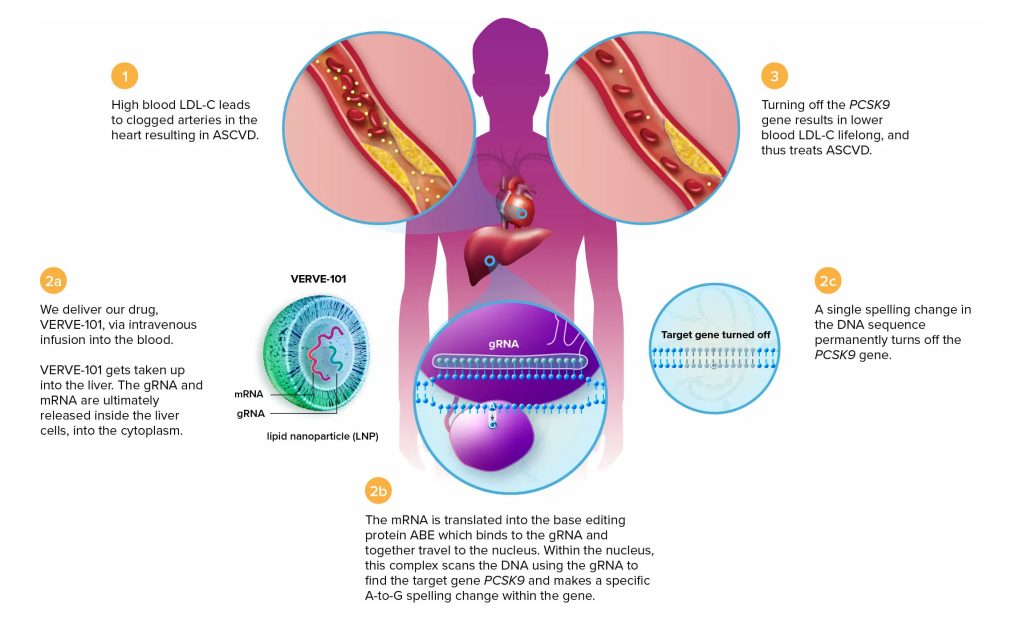
This phase 1 trial has been ongoing in New Zealand and the United Kingdom. The first participant received the treatment in July 2022, and a total of 10 participants have received the treatment. The first three participants were given a low dose and, once safety had been established, the next participants were given medium or high doses of the treatment. The two participants given the middle dose saw a 39% and 48% reduction in LDL cholesterol, respectively, while the participant given the highest dose saw a 55% reduction. These changes have been stable for six months, with monitoring ongoing. These are larger reductions than seen with statin medications, the conventional treatment for high LDL cholesterol. The levels of PCSK9 protein in the blood are also lower.
Some participants experienced mild adverse events, including flu-like symptoms. However, there were also three serious cardiovascular events. Two of these events, including the one that led to a death, were determined to be due to severe underlying coronary artery disease, while one was determined to potentially be related to treatment.
The trial was originally intended to also enroll US participants, but was put on hold in the US due to an FDA request for additional data on the treatment itself and on risks of editing in germline cells (i.e., sperm and eggs). After providing more data, Verve got the green light to resume the trial in the US in October 2023. Verve is currently enrolling more participants for the medium and high dose cohorts. They plan to initiate a placebo-controlled phase 2 trial in 2025.
Read more:
- First trial of ‘base editing’ in humans lowers cholesterol — but raises safety concerns
- New Gene Editing Treatment Cuts Dangerous Cholesterol in Small Study
- Latest data from Verve
In 2023, CRISPR Therapeutics initiated two phase 1 trials for additional targets for cardiovascular disease. Like the Verve trial, they rely on LNP delivery to the liver.
One trial targets angiopoietin-like 3 protein (ANGPTL3). Individuals who naturally have gene variants of ANGPTL3 that lead to reduced levels of the protein have reduced levels of lipids, or fats, and the blood and reduced risk of heart disease. The other trial targets lipoprotein(a) (Lp(a)). High levels of Lp(a) are also associated with heart disease. Unlike the PCSK9 trial, which targets a relatively rare gene variant associated with heart disease, these two trials are aimed at modifying the “wild type,” or, common version of a gene in individuals who may or may not have genetic risks for cardiovascular disease. If successful, these therapies would be aimed at much broader sections of the population. In fact, about one in five people in the United States and globally have elevated Lp(a). They have plans to target PCSK9 in the future as well.
“Statin drugs like Lipitor were not initially trialed for prevention of cardiovascular disease in a general population,” says Urnov. “They were first trialed in people with severe cardiovascular disease due to genetic hyperlipidemia. Then they were trialed for people with significant, non-genetic cardiovascular disease. Finally, for prevention of cardiovascular disease. This is the model that Verve and CRISPR Therapeutics are following — first editing these genes in people with dangerous genetic variants. But we know from other research that editing these genes could prevent cardiovascular disease broadly. The real question is how quickly they move from genetic disease into prevention.”
HIV/AIDS
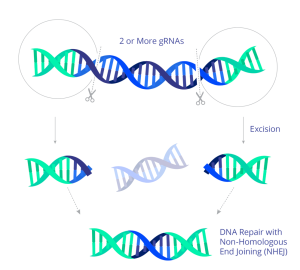
In 2022, the first participants were dosed in a US trial using CRISPR to treat HIV. The experimental treatment uses CRISPR genome-editing molecules to target the HIV DNA sequence stored in the host cell genome. In preclinical work, the guide RNAs direct the Cas9 protein to cut at two sites within the HIV genome, surgically excising most of the genome and effectively eliminating HIV from the cell. The CRISPR treatment is delivered by an AAV9 viral vector and administered by infusion in a single treatment.
The phase 1 trial, which is sponsored by Excision Biotherapeutics, is the first to target HIV or any other chronic viral infection. The first participant was dosed in July 2022 and two more participants have since been dosed. As of October 2023, there were no reports of significant severe adverse effects. The company plans to to give a higher dose of the treatment to a second cohort, now that basic safety has been shown. This treatment has been given FDA Fast Track designation.
Read more:
DIABETES
Researchers have long been interested in transplanting healthy pancreatic cells into individuals with type-1 diabetes (T1-D). While ongoing clinical trials in this area show that pancreatic cell transplantation can greatly benefit individuals with T1D, individuals who receive conventional pancreatic cell transplants must take drugs that suppress the immune system on an ongoing basis so that their body does not attack the transplanted cells. Immunosuppressant drugs can have serious side effects, including increased risk of dangerous infections and cancers.
In 2022, we reported the start of a new clinical trial using pancreatic cells made from stem cells. CRISPR was used to edit the immune-related genes of these cells so that the patient’s immune system would not attack them. The cells were implanted into a patient’s body in a special pouch. Ideally, blood vessels would grow along the outside of the pouch, bringing the cells oxygen and vital nutrients from the blood, and taking up insulin from the cells. The aim was for patients to have healthy new pancreas cells to help control or even cure their T1D without having to take immunosuppressants. Stem-cell derived pancreatic cells also have a scalability advantage over conventional donor-matched or autologous transplants.
This phase 1 trial was sponsored by CRISPR Therapeutics and ViaCyte and was the first use of CRISPR to treat an endocrine disease. However, shortly after the first patient was dosed in Spring 2022, ViaCyte was acquired by Vertex Pharmaceuticals and the trial was put on hold. The intellectual property rights have since been fully transferred to CRISPR Therapeutics and they intend to continue the phase 1 trial.
Read more:
- Sweet Spot: CRISPR Therapeutics, ViaCyte Dose First Patient with Cell Therapy for Type 1 Diabetes — Includes more detailed information on the approach
- Vertex cuts ties to CRISPR Therapeutics’ type 1 diabetes stem cell therapy
AUTOIMMUNE DISEASE
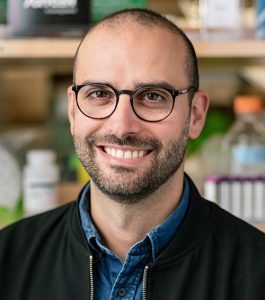
Autoimmune diseases occur when the body’s immune system mistakenly targets the body’s own healthy cells and tissues. Systemic lupus erythematosus (SLE) is a chronic autoimmune condition that can cause tissue damage in almost any system of the body, most frequently affecting the skin, joints, kidneys, and heart. In severe cases, SLE can be disabling and cause life-shortening kidney disease and heart failure. SLE, like most autoimmune conditions, disproportionately affects women. In the US, the disease is more prevalent and more severe in women of color. Common treatments include hydroxychloroquine, steroids, and immunosuppressant medications, all of which can have serious side effects.
A small study in 2019 showed that conventional (non-gene-edited), autologous CAR-T cell therapy could put SLE into remission. Now, over 10 trials using conventional CAR-T to treat SLE are underway. CRISPR Therapeutics is initiating a trial treating patients with SLE with their next-generation CD19-targeting CAR-T cells. This will be the first application of CRISPR to the autoimmune space.
“People are super excited about this right now,” says Eyquem. “To treat cancer with CAR-T cells, the cells need to be able to persist in the body for a very long time, which remains a big challenge for allogeneic CAR-T cells. But preliminary clinical data suggest that it may not be true for treating autoimmune disorders. For autoimmunity, CAR-T could be used to quickly cause a complete depletion of immune cells called B cells. It seems like this can actually reset the patient’s immune system and have significant therapeutic benefit without needing the immunotherapy cells to persist for a long time. Right now, almost all CAR-T companies are opening an autoimmune disorder branch.”
Refer to the cancer section above for more information on CAR-T.
Read more:
OUTLOOK
As the IGI has tracked CRISPR clinical trials each year, we’ve seen both an expansion in number and also in the disease areas being investigated, all on a remarkably short time scale. At the same time, there is growing understanding that novel regulatory approaches are needed to fully realize the therapeutic potential of CRISPR, especially for rare diseases. The traditional clinical trial pathway for the treatment that might be given to 10 patients a year can’t be the same as for treatment that will be given to 100,000. Europe, for example, has instituted the Hospital Exemption Rule, intended to benefit individuals with ultra-rare diseases. It allows an investigational genetic therapy to be developed at a hospital for use in a single patient.
New approaches to regulating platform technologies could also benefit rare disease patients. A platform technology is when all the parts of a treatment are standardized into a single off-the-shelf package and only certain pieces of the platform change for a given disease. For CRISPR-based treatments, for example different disease-causing mutations within the same gene, the standardized part of the treatment would be the Cas protein that cuts DNA, the method of delivery to the cells, how the treatment is administered, and what dose a patient gets. The only thing that would change would be the sequence of the guide RNA and any DNA repair templates that need to be specified for different edits.
“The vision is that going from treating one condition to another will be much faster, cheaper, and more scalable than going back to square one,” says Urnov.
In 2022, the U.S. Congress passed legislation directing the FDA to create a platform technology designation. We hope to have more information on this legislation at our next update.
CLOSED TRIALS
Sickle Cell Disease
- As of 2022, two groups were taking the alternative approach of directly correcting the disease-causing gene variant for SCD to the more common, healthy variant. In 2022, Graphite Bio dosed one participant in their phase 1/2 trial. Their approach combines electroporation to get the CRISPR proteins into the cell and a viral vector to get a DNA “template” that the new gene variant can be copied off of into the cell. In early January 2023, Graphite shared that the first participant is experiencing prolonged low blood cell counts (pancytopenia) requiring ongoing blood transfusions and other treatments. Graphite reported the event to the FDA and is investigating what happened. Initially, they decided to voluntarily pause the trial, but recently announced that they are discontinuing development of their SCD treatment.
- A phase 1/2 trial from Novartis and Intellia Therapeutics that takes the same approach as Casgevy had positive initial results, though the companies decided to discontinue in early 2023.
Cancer
- PACT Pharma did a US-based phase 1 trial for metastasized bladder, lung, head and neck, colorectal, ovarian, breast, and prostate cancers. Their approach was to analyze an individual tumor genome, and then use CRISPR to make an individual’s T cells target their specific tumor. Up to three different engineered T cells were given to each patient in their single-dose treatment. In November 2022, they shared data, stating that the gene-editing T cells preferentially infiltrated tumors, and led to tumor size reduction in one of 16 treated individuals. They have since suspended the trial as a business decision.
- Presumed closed: Bioray Laboratories in conjunction with Zhejiang University have also shared positive results from a phase 1 trial in China for a similar product. In their study, 7/8 participants observed for about a year had a complete remission and durable responses without serious adverse events.
Genetic Blindness
- Leber congenital amaurosis (LCA), the most common cause of inherited childhood blindness. LCA10 was the target of the first in vivo CRISPR therapy trial, held in the US and sponsored by Editas Medicine. The first patient was dosed in March 2020 and dosing of small cohorts continued through July 2022. In November 2020, Editas revealed that only three out of 14 patients had “clinically meaningful” changes to their vision. Two of the three responders had mutations in both of their copies of the relevant gene, suggesting that this treatment may be most effective in this subset of the LCA10 population.This subset of an already rare condition is represented by only about 300 individuals in the United States. Because the patient population is so small, Editas has decided to stop clinical development of this treatment.
Duchenne Muscular Dystrophy
- Muscular dystrophies are a group of disorders that lead to muscle wasting and weakness. Duchenne Muscular Dystrophy (DMD) is the most severe form. Biotech nonprofit Cure Rare Disease (CRD) created a personalized treatment for an individual with DMD. The aim of the treatment was to increase production of an alternate form of the dystrophin protein. The participant was dosed in 2023 and died after the administration of the treatment. This is the first death associated with a CRISPR clinical trial. An autopsy of the participant showed that the cause of death was acute respiratory distress syndrome (ARDS), a severe inflammation of the lungs. ARDS was triggered by an immune response to the virus (AAV6) used to deliver the CRISPR components. The inflammation was caused by a reaction from the innate immune system. ARDS has not previously been documented as a response to genomic medicines delivered with this virus and the reaction could not have been predicted.
MORE INFORMATION ON CLINICAL TRIALS
If you or a loved one are interested in participating in a clinical trial, learn more about how US-based clinical trials work and where to find them on our Patients & Families page. Discuss all important medical decisions with your doctor. Keep in mind that clinical trials are the first tests of new medical treatments, so they are inherently risky and never guaranteed to be successful.
Thanks to Fyodor Urnov, Justin Eyquem, and Brian Shy for information and insights for this piece.
 By
Hope Henderson
By
Hope Henderson
Hope Henderson holds a B.A. in Biology from Brown University and a Ph.D. in Molecular & Cell Biology from the University of California, Berkeley. She joined the IGI in 2019 to work in science communication. In addition to serving as IGI’s main writer, she plans content strategy and manages IGI’s social media, illustration, and translation.



